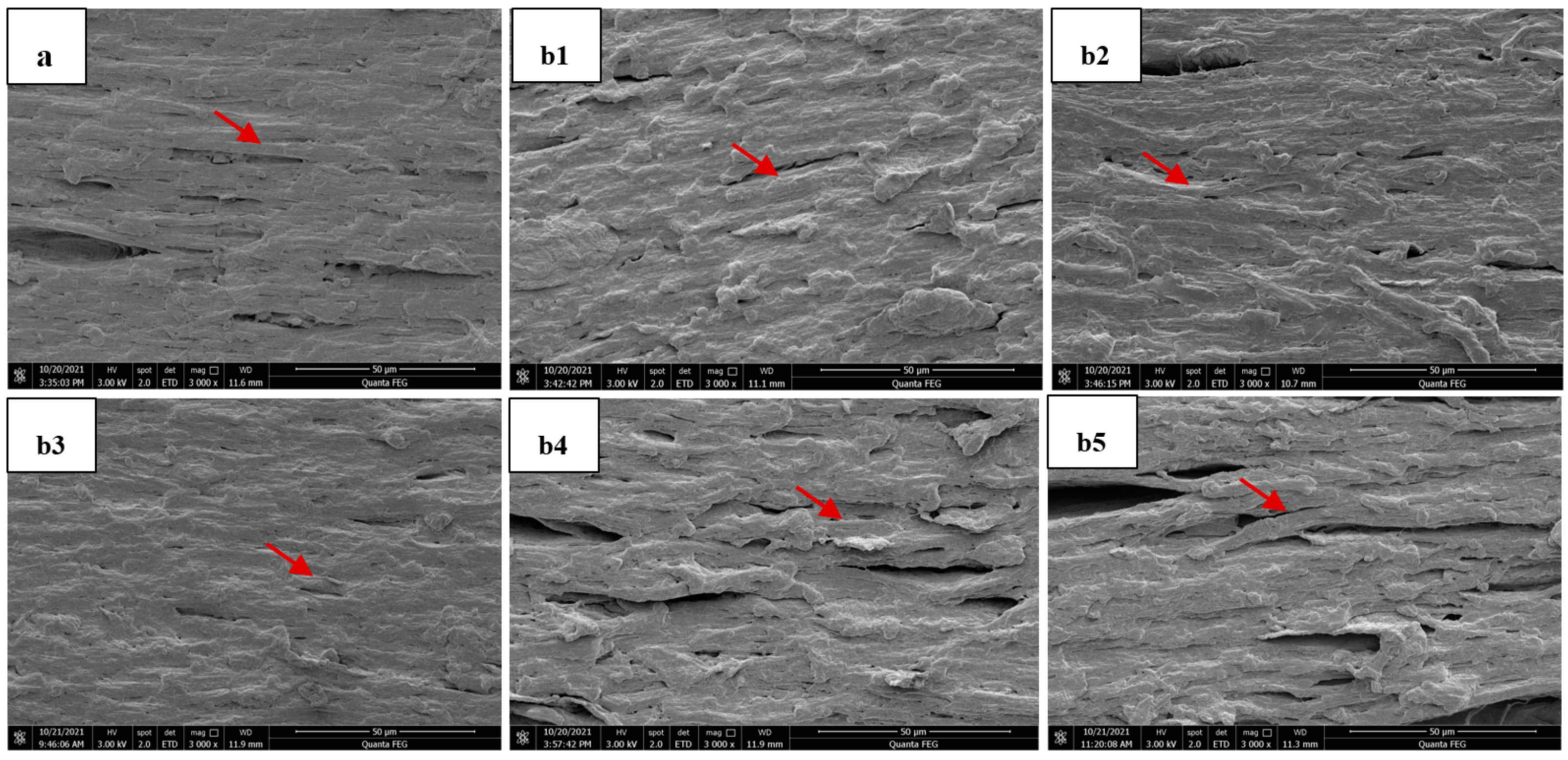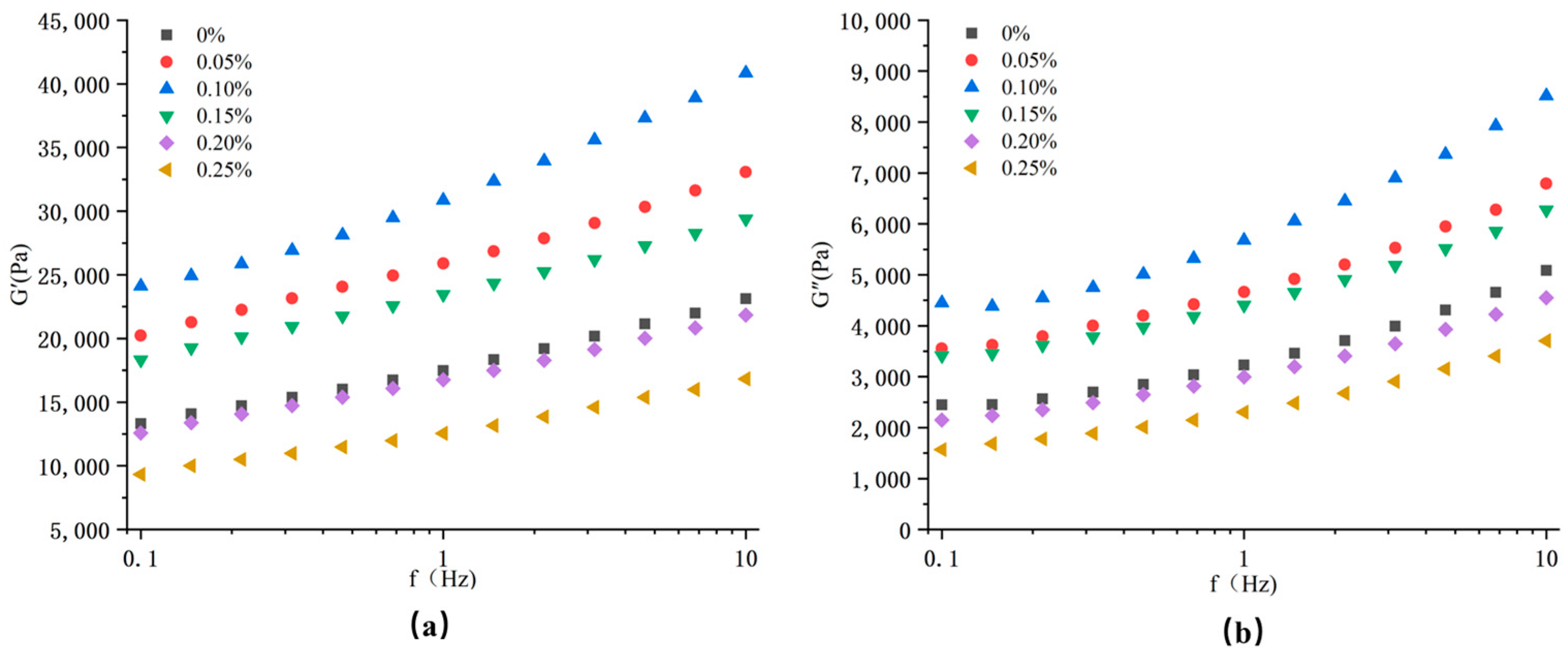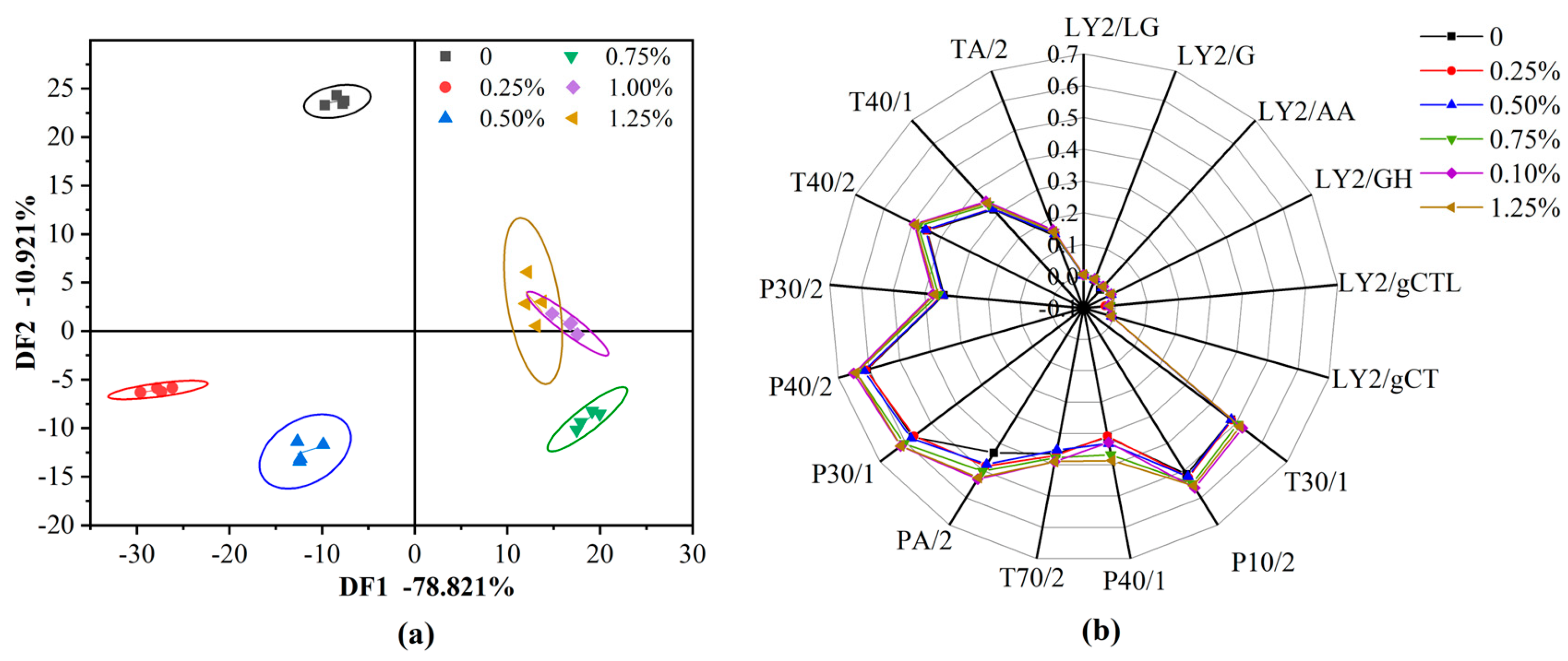Effects of Cysteine on Physicochemical Properties of High-Moisture Extrudates Prepared from Plant Protein
Abstract
:1. Introduction
2. Materials and Methods
2.1. Materials
2.2. Extrusion Experiments
2.3. Color Determination
2.4. Texturization Degree Determination
2.5. Texture Properties Determination
2.6. Microstructure Observation
2.7. Rheological Properties Determination
2.8. Protein Solubility Determination
2.9. Fourier Transform Infrared Spectroscope Determination
2.10. Electronic Nose Measurement
2.11. Statistical Analysis
3. Results and Discussion
3.1. Color of the Extrudates
3.2. Texturization Degree and Texture Properties
3.3. Microstructure
3.4. Rheological Properties
3.5. Protein Solubility
3.6. Secondary Structure
3.7. Odor Analysis
4. Conclusions
Author Contributions
Funding
Data Availability Statement
Conflicts of Interest
References
- Tilman, D.; Clark, M. Global diets link environmental sustainability and human health. Nature 2014, 515, 518–522. [Google Scholar] [CrossRef] [PubMed]
- Clark, B.; Stewart, G.B.; Panzone, L.A.; Kyriazakis, I.; Frewer, L.J. Citizens, consumers and farm animal welfare: A meta-analysis of willingness-to-pay studies. Food Policy. 2017, 68, 112–127. [Google Scholar] [CrossRef] [Green Version]
- Kumar, P.; Chatli, M.K.; Mehta, N.; Singh, P.; Malav, O.P.; Verma, A.K. Meat analogues: Health promising sustainable meat substitutes. Crit. Rev. Food Sci. Nutr. 2017, 57, 923–932. [Google Scholar] [CrossRef] [PubMed]
- Sanchez-Sabate, R.; Sabate, J. Consumer attitudes towards environmental concerns of meat consumption: A systematic review. Int. J. Environ. Res. Public Health 2019, 16, 1220. [Google Scholar] [CrossRef] [Green Version]
- Sha, L.; Xiong, Y.L. Plant protein-based alternatives of reconstructed meat: Science, technology, and challenges. Trends Food Sci. Technol. 2020, 102, 51–61. [Google Scholar] [CrossRef]
- Dekkers, B.L.; Boom, R.M.; Goot, A.J. Structuring processes for meat analogues. Trends Food Sci. Technol. 2018, 81, 25–36. [Google Scholar] [CrossRef]
- Zhang, J.; Liu, L.; Jiang, Y.; Shah, F.; Xu, Y.; Wang, Q. High-moisture extrusion of peanut protein-/carrageenan/sodium alginate/wheat starch mixtures: Effect of different exogenous polysaccharides on the process forming a fibrous structure. Food Hydrocoll. 2020, 99, 105311. [Google Scholar] [CrossRef]
- Choton, S.; Gupta, N.; Bandral, J.; Anjum, N.; Choudary, A. Extrusion technology and its application in food processing: A review. Pharma. Innov. 2020, 9, 162–168. [Google Scholar] [CrossRef]
- Pietsch, V.L.; Bühler, J.M.; Karbstein, H.P.; Emin, M.A. High moisture extrusion of soy protein concentrate: Influence of thermomechanical treatment on protein-protein interactions and rheological properties. J. Food Eng. 2019, 251, 11–18. [Google Scholar] [CrossRef]
- Zhang, J.; Li, L.; Liu, H.; Ashton, Y.; Rizvi, S.; Qiang, W. Changes in conformation and quality of vegetable protein during texturization process by extrusion. Crit. Rev. Food Sci. Nutr. 2018, 59, 3267–3280. [Google Scholar] [CrossRef]
- Osen, R.; Schweiggert-Weisz, U. High-moisture extrusion: Meat analogues. In Reference Module in Food Science; Fraunhofer: Munchen, Germany, 2016. [Google Scholar] [CrossRef]
- Schreuders, F.; Dekkers, B.L.; Bodnar, I.; Erni, P.; Boom, R.M.; Jan, V. Comparing structuring potential of pea and soy protein with gluten for meat analogue preparation. J. Food Eng. 2019, 261, 32–39. [Google Scholar] [CrossRef]
- Mosibo, O.K.; Ferrentino, G.; Alam, M.R.; Morozova, K.; Scampicchio, M. Extrusion cooking of protein-based products: Potentials and challenges. Crit. Rev. Food Sci. Nutr. 2020, 62, 1–35. [Google Scholar] [CrossRef] [PubMed]
- Hughes, G.J.; Ryan, D.J.; Mukherjea, R.; Schasteen, C.S. Protein digestibility-corrected amino acid scores (pdcaas) for soy protein isolates and concentrate: Criteria for evaluation. J. Agric. Food Chem. 2011, 59, 12707–12712. [Google Scholar] [CrossRef] [PubMed]
- Chao, W.X. Health effects of soy protein and isoflavones in humans. J. Nutr. 2008, 138, 1244–1249. [Google Scholar] [CrossRef]
- Joshi, V.K.; Kumar, S. Meat Analogues: Plant based alternatives to meat products-A review. Int. J. Food Ferment. Technol. 2015, 5, 107–119. [Google Scholar] [CrossRef]
- Grabowska, K.J.; Tekidou, S.; Boom, R.M.; Atze-Jan, V. Shear structuring as a new method to make anisotropic structures from soy-gluten blends. Food Res. Int. 2014, 64, 743–751. [Google Scholar] [CrossRef]
- Chiang, J.H.; Loveday, S.M.; Hardacre, A.K.; Parker, M.E. Effects of soy protein to wheat gluten ratio on the physicochemical properties of extruded meat analogues. Food Struct. 2019, 19, 100102. [Google Scholar] [CrossRef]
- Ning, L.; Villota, R. Influence of 7S and 11S globulins on the extrusion performance of soy protein concentrates. J. Food Process. Pres. 1994, 18, 421–436. [Google Scholar] [CrossRef]
- Liu, K.S.; Hsieh, F.H. Protein-protein interactions during high-moisture extrusion for fibrous meat analogues and comparison of protein solubility methods using different solvent systems. J. Agric. Food Chem. 2008, 56, 2681. [Google Scholar] [CrossRef]
- Li, M.; Lee, T.C. Effect of cysteine on the functional properties and microstructures of wheat flour extrudates. J. Agric. Food Chem. 1996, 44, 1871–1880. [Google Scholar] [CrossRef]
- Lambert, I.A.; Kokini, J.L. Effect of L-cysteine on the rheological properties of wheat flour. Cereal Chem. 2001, 78, 226–230. [Google Scholar] [CrossRef]
- Farmer, L.J.; Mottram, D.S.; Whitfield, F.B. Volatile compounds produced in maillard reactions involving cysteine, ribose and phospholipid. J. Sci. Food Agric. 1989, 49, 347–368. [Google Scholar] [CrossRef]
- Hofmann, T.; Schieberle, P. Evaluation of the key odorants in a thermally treated solution of ribose and cysteine by aroma extract dilution techniques. J. Agric. Food Chem. 1995, 43, 2187–2194. [Google Scholar] [CrossRef]
- Sotillo, E.; Hettlarachchy, N.S. Corn meal-sunflower meal extrudates and their physicochemical properties. J. Food Sci. 1994, 59, 432–435. [Google Scholar] [CrossRef]
- Chen, F.L.; Wei, Y.M.; Zhang, B.; Ojokoh, A.O. System parameters and product properties response of soybean protein extruded at wide moisture range. J. Food Eng. 2010, 96, 208–213. [Google Scholar] [CrossRef]
- Osen, R.; Toelstede, S.; Wild, F.; Eisner, P.; Schweiggert-Weisz, U. High moisture extrusion cooking of pea protein isolates: Raw material characteristics, extruder responses, and texture properties. J. Food Eng. 2014, 127, 67–74. [Google Scholar] [CrossRef]
- Fang, Y.; Zhang, B.; Wei, Y. Effects of the specific mechanical energy on the physicochemical properties of texturized soy protein during high-moisture extrusion cooking. J. Food Eng. 2014, 121, 32–38. [Google Scholar] [CrossRef]
- Guo, X.N.; Gao, F.; Zhu, K.X. Effect of fresh egg white addition on the quality characteristics and protein aggregation of oat noodles. Food Chem. 2020, 330, 127319. [Google Scholar] [CrossRef]
- Feng, L.C.; Yi, M.W.; Bo, Z. Chemical cross-linking and molecular aggregation of soybean protein during extrusion cooking at low and high moisture content. LWT Food Sci. Technol. 2011, 44, 957–962. [Google Scholar] [CrossRef]
- Luo, Y.; Li, M.; Zhu, K.X.; Guo, X.N.; Peng, W.; Zhou, H.M. Heat-induced interaction between egg white protein and wheat gluten. Food Chem. 2016, 197, 699–708. [Google Scholar] [CrossRef]
- Wojnowski, W.; Majchrzak, T.; Dymerski, T.; Gbicki, J.; Namienik, J. Electronic noses: Powerful tools in meat quality assessment. Meat Sci. 2017, 131, 119–131. [Google Scholar] [CrossRef] [PubMed]
- Madiha, B.; Khalid, T.; Zouhair, H.; Tarik, S.; Nezha, E.B.; Benachir, B. Detection of adulteration in argan oil by using an electronic nose and a voltammetric electronic tongue. J. Sensors 2014, 2014, 727–737. [Google Scholar] [CrossRef] [Green Version]
- Yasir, S.; Sutton, K.H.; Newberry, M.P.; Andrews, N.R.; Gerrard, J.A. The impact of maillard cross-linking on soy proteins and tofu texture. Food Chem. 2007, 104, 1502–1508. [Google Scholar] [CrossRef]
- Zahari, I.; Ferawati, F.; Helstad, A.; Ahlström, C.; Östbring, K.; Rayner, M.; Purhagen, J.K. Development of High-Moisture Meat Analogues with Hemp and Soy Protein Using Extrusion Cooking. Foods 2020, 9, 772. [Google Scholar] [CrossRef]
- Sandoval Murillo, J.L.; Osen, R.; Hiermaier, S.; Ganzenmüller, G. Towards understanding the mechanism of fibrous texture formation during high-moisture extrusion of meat substitutes. J. Food Eng. 2019, 242, 8–20. [Google Scholar] [CrossRef]
- Zou, Y.; Yang, X.; Scholten, E. Rheological behavior of emulsion gels stabilized by zein/tannic acid complex particles. Food Hydrocoll. 2018, 77, 363–371. [Google Scholar] [CrossRef]
- Gosal, S.W.; Ross-Murphy, B.S. Globular protein gelation. Curr. Opin. Colloid Interface Sci. 2000, 5, 188–194. [Google Scholar] [CrossRef]
- Brishti, F.H.; Chay, S.Y.; Muhammad, K.; Ismail-Fitry, M.R.; Zarei, M.; Karthikeyan, S. Structural and rheological changes of texturized mung bean protein induced by feed moisture during extrusion. Food Chem. 2021, 344, 128643. [Google Scholar] [CrossRef]
- Wei, Y.; Zhang, C.; Zhang, B.; Kang, L. Changes of chemical bonds in peanut protein high moisture extrusion texturization. Sci. Agric. Sin. 2007, 40, 2575–2581. [Google Scholar] [CrossRef]
- Nor Afizah, M.; Rizvi, S.S.H. Functional properties of whey protein concentrate texturized at acidic pH: Effect of extrusion temperature. LWT Food Sci. Technol. 2014, 57, 290–298. [Google Scholar] [CrossRef]
- Peng, H.; Zhang, J.; Wang, S.; Qi, M.; Yue, M.; Zhang, S. High moisture extrusion of pea protein: Effect of l-cysteine on product properties and the process forming a fibrous structure. Food Hydrocoll. 2022, 129, 107633. [Google Scholar] [CrossRef]
- Carbonaro, M.; Maselli, P.; Nucara, A. Relationship between digestibility and secondary structure of raw and thermally treated legume proteins: A fourier transform infrared (FT-IR) spectroscopic study. Amino Acids 2011, 43, 911–921. [Google Scholar] [CrossRef] [PubMed]
- Choi, S.M.; Ma, C.Y. Structural characterization of globulin from common buckwheat (Fagopyrum esculentum Moench) using circular dichroism and Raman spectroscopy. Food Chem. 2007, 102, 150–160. [Google Scholar] [CrossRef]
- Zhou, L.; Zhang, Y.; Zhao, C.; Lin, H.; Wang, Z.; Wu, F. Structural and functional properties of rice bran protein oxidized by peroxyl radicals. Int. J. Food Prop. 2017, 20, 1456–1467. [Google Scholar] [CrossRef] [Green Version]
- Li, X.; Liu, T.; Song, L.; Zhang, H.; Li, L.; Gao, X. Influence of high-molecular- weight glutenin subunit composition at Glu-A1 and Glu-D1 loci on secondary and micro structures of gluten in wheat (Triticum aestivum L.). Food Chem. 2016, 213, 728–734. [Google Scholar] [CrossRef]
- Beck, S.M.; Knoerzer, K.; Arcot, J. Effect of low moisture extrusion on a pea protein isolate’s expansion, solubility, molecular weight distribution and secondary structure as determined by Fourier Transform Infrared Spectroscopy (FTIR). J. Food Eng. 2017, 214, 166–174. [Google Scholar] [CrossRef]
- Loutfi, A.; Coradeschi, S.; Mani, G.K.; Shankar, P.; Rayappan, J.B.B. Electronic noses for food quality: A review. J. Food Eng. 2015, 144, 103–111. [Google Scholar] [CrossRef]
- Gu, D.; Liu, W.; Yan, Y.; We, W.; Gan, J.; Lu, Y.; Jang, Z.; Wang, X.; Xu, C. A novel method for rapid quantitative evaluating formaldehyde in squid based on electronic nose. LWT Food Sci. Technol. 2019, 101, 382–388. [Google Scholar] [CrossRef]
- Chen, J.; Tao, L.; Zhang, T.; Zhang, J.; Wu, T.; Luan, D.; Ni, L.; Wang, X.; Zhong, J. Effect of four types of thermal processing methods on the aroma profiles of acidity regulator-treated tilapia muscles using E-nose, HS-SPME-GC-MS, and HS-GC-IMS. LWT Food Sci. Technol. 2021, 147, 111585. [Google Scholar] [CrossRef]
- Shu, C.K.; Hagedorn, M.L.; Mookherjee, B.D.; Ho, C.T. pH Effect on the volatile components in the thermal degradation of cysteine. J. Agric. Food Chem. 1985, 33, 442–446. [Google Scholar] [CrossRef]




| Cysteine Content (%) | L* | a* | b* | ΔE* |
|---|---|---|---|---|
| 0 | 60.77 ± 0.27 a | 7.11 ± 0.17 a | 11.45 ± 0.22 c | 39.92 ± 0.19 b |
| 0.05 | 59.81 ± 0.50 b | 7.18 ± 0.10 a | 11.69 ± 0.30 bc | 40.90 ± 0.55 a |
| 0.10 | 60.04 ± 0.35 ab | 7.15 ± 0.15 a | 11.69 ± 0.63 bc | 40.69 ± 0.52 ab |
| 0.15 | 59.78 ± 0.15 b | 7.05 ± 0.08 ab | 11.67 ± 0.62 bc | 40.92 ± 0.34 a |
| 0.20 | 60.05 ± 0.81 ab | 6.90 ± 0.09 b | 12.36 ± 0.42 ab | 41.10 ± 0.74 a |
| 0.25 | 59.61 ± 0.43 b | 6.89 ± 0.11 b | 12.66 ± 0.72 a | 41.46 ± 0.35 a |
| Cysteine Content (%) | Texturization Degree | Hardness (kg) | Springiness (%) | Chewiness (kg) |
|---|---|---|---|---|
| 0 | 2.00 ± 0.09 b | 20.96 ± 0.31 ab | 95.84 ± 2.29 b | 17.59 ± 0.93 ab |
| 0.05 | 2.35 ± 0.10 a | 21.26 ± 0.16 a | 97.11 ± 1.53 a | 17.90 ± 0.36 a |
| 0.10 | 2.23 ± 0.11 a | 21.25 ± 0.64 a | 97.66 ± 0.35 a | 17.98 ± 0.57 a |
| 0.15 | 2.24 ± 0.01 a | 21.04 ± 0.32 ab | 98.00 ± 0.03 a | 17.52 ± 0.29 ab |
| 0.20 | 1.80 ± 0.12 c | 20.58 ± 0.20 b | 91.50 ± 0.62 c | 16.73 ± 0.20 b |
| 0.25 | 1.51 ± 0.12 c | 20.45 ± 0.38 b | 91.79 ± 1.41 c | 16.84 ± 0.29 b |
| Cysteine Content (%) | Hydrogen Bonds (mg/g) | Hydrophobic Interactions (mg/g) | Disulfide Bonds (mg/g) |
|---|---|---|---|
| 0 | 21.66 ± 0.20 e | 18.55 ± 0.12 e | 4.67 ± 0.01 bc |
| 0.05 | 23.27 ± 0.25 d | 23.47 ± 0.06 a | 4.82 ± 0.07 b |
| 0.10 | 26.84 ± 0.19 c | 22.89 ± 0.05 b | 5.75 ± 0.02 a |
| 0.15 | 28.60 ± 0.09 a | 22.44 ± 0.09 c | 4.81 ± 0.07 b |
| 0.20 | 27.67 ± 0.15 b | 22.92 ± 0.03 b | 4.60 ± 0.02 c |
| 0.25 | 26.31 ± 0.07 c | 21.82 ± 0.21 d | 4.21 ± 0.02 d |
| Cysteine Content (%) | α-Helix (%) | β-Sheet (%) | β-Turn (%) | Random Coil (%) |
|---|---|---|---|---|
| 0 | 19.50 ± 0.07 ab | 33.16 ± 0.14 a | 28.21 ± 0.05 b | 19.12 ± 0.01 c |
| 0.05 | 19.58 ± 0.16 ab | 32.67 ± 0.36 a | 28.06 ± 0.06 b | 19.70 ± 0.12 c |
| 0.10 | 19.25 ± 0.07 b | 32.45 ± 0.63 a | 28.81 ± 0.64 ab | 19.50 ± 0.18 c |
| 0.15 | 19.83 ± 0.13 a | 30.55 ± 0.29 b | 29.73 ± 0.28 a | 19.89 ± 0.44 b |
| 0.20 | 19.50 ± 0.03 ab | 30.54 ± 0.41 b | 29.43 ± 0.31 a | 20.53 ± 0.08 a |
| 0.25 | 19.38 ± 0.18 b | 30.01 ± 0.60 b | 29.78 ± 0.17 a | 20.83 ± 0.25 a |
Publisher’s Note: MDPI stays neutral with regard to jurisdictional claims in published maps and institutional affiliations. |
© 2022 by the authors. Licensee MDPI, Basel, Switzerland. This article is an open access article distributed under the terms and conditions of the Creative Commons Attribution (CC BY) license (https://creativecommons.org/licenses/by/4.0/).
Share and Cite
Dai, H.; An, H. Effects of Cysteine on Physicochemical Properties of High-Moisture Extrudates Prepared from Plant Protein. Foods 2022, 11, 3109. https://doi.org/10.3390/foods11193109
Dai H, An H. Effects of Cysteine on Physicochemical Properties of High-Moisture Extrudates Prepared from Plant Protein. Foods. 2022; 11(19):3109. https://doi.org/10.3390/foods11193109
Chicago/Turabian StyleDai, Huihui, and Hongzhou An. 2022. "Effects of Cysteine on Physicochemical Properties of High-Moisture Extrudates Prepared from Plant Protein" Foods 11, no. 19: 3109. https://doi.org/10.3390/foods11193109




